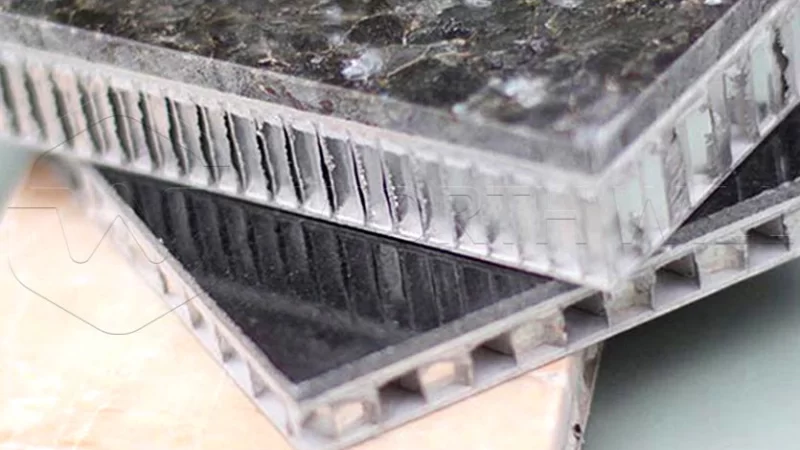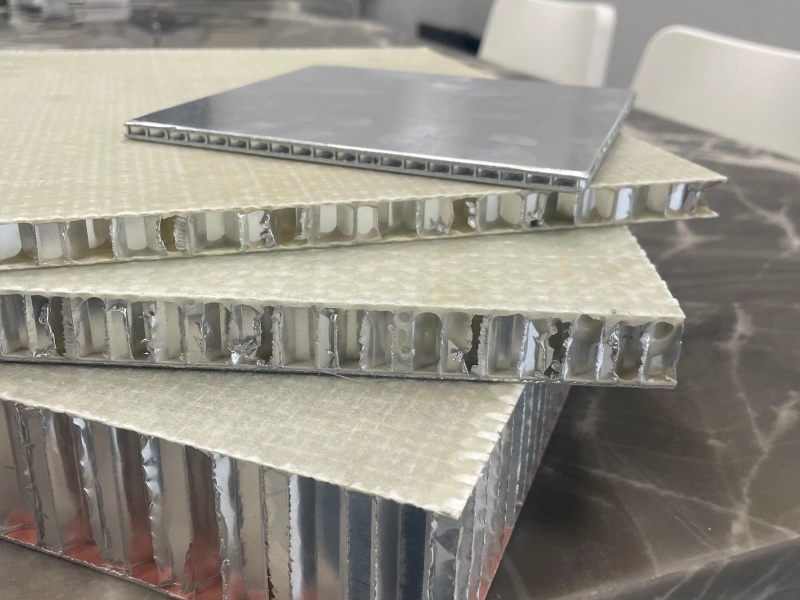What is an Aluminum Honeycomb Panel?
An aluminum honeycomb panel is a composite sandwich structure. It consists of two thin aluminum skins bonded to a thicker core of hexagonal aluminum cells, resembling a honeycomb. This unique construction provides an incredibly rigid and lightweight panel. The honeycomb core efficiently distributes forces, allowing the panel to withstand significant loads without excessive weight, making it an ideal solution for applications requiring both high performance and reduced mass.
Why Choose Aluminum Honeycomb Panels?
The advantages of using aluminum honeycomb panels are numerous, making them a top choice across various industries.
- Exceptional Strength-to-Weight Ratio: This is the primary benefit. Despite being incredibly lightweight, these panels offer remarkable stiffness and strength, surpassing many traditional building materials.
- Superior Flatness: The honeycomb structure ensures excellent flatness, which is essential for aesthetic applications and precision engineering.
- Fire Resistance: Aluminum is non-combustible, and the air trapped within the honeycomb cells further enhances fire resistance.
- Corrosion Resistance: The inherent properties of aluminum make these panels highly resistant to rust and corrosion, even in harsh environments.
- Thermal and Acoustic Insulation: The air pockets in the honeycomb core provide good thermal insulation and sound dampening properties.
- Durability and Longevity: Aluminum honeycomb panels are resistant to moisture, chemicals, and UV radiation, ensuring a long service life with minimal maintenance.
- Versatility: They can be easily cut, formed, and finished, allowing for a wide range of custom designs and applications.
- Eco-Friendly: Aluminum is 100% recyclable, making these panels a sustainable choice for environmentally conscious projects.
Specification: Key Considerations When Buying
When working with aluminum honeycomb panel suppliers, understanding the key specifications is vital to ensure the panels meet your project’s requirements.
Panel Thickness
The overall thickness of the aluminum honeycomb panel directly impacts its stiffness and strength. Common thicknesses range from 6mm to 300mm, with custom options available depending on the supplier and application. Thicker panels offer greater rigidity.
Aluminum Skin Thickness
The thickness of the top and bottom aluminum skins (or face sheets) typically ranges from 0.5mm to 3.0mm. Thicker skins contribute to higher impact resistance and structural integrity.
Core Cell Size
The honeycomb core consists of hexagonal cells. The cell size (diameter) affects the panel’s properties. Smaller cell sizes generally provide higher compressive strength and shear strength, making the panel more rigid and suitable for high-load applications. Common cell sizes range from 3.2mm to 25.4mm.
Panel Dimensions
Aluminum honeycomb panel suppliers can offer panels in standard dimensions or custom sizes to minimize waste and facilitate installation. Typical widths can go up to 1500mm and lengths up to 10000mm, though larger custom sizes are possible.
Surface Finishes
The surface finish profoundly impacts the panel’s aesthetics and protective qualities. Common finishes include:
- PVDF Coating: Highly durable, excellent color retention, and UV resistant, ideal for exterior architectural applications.
- PE Coating: Economical, good for interior use, offers a wide range of colors.
- Anodized Finish: Creates a tough, corrosion-resistant, and aesthetically pleasing surface.
- Powder Coating: Provides a robust and decorative finish with various color options.
- Mill Finish: Raw aluminum, often used when the panel will be painted or laminated further.
Classification: Understanding the Types
Aluminum honeycomb panels can be classified based on their application, core type, and surface treatment.
By Application
- Exterior Wall Cladding Panels: Designed to withstand outdoor elements, often with robust PVDF coatings and thicker skins for durability and weather resistance.
- Interior Decorative Panels: Focus on aesthetics, sound absorption, and ease of installation, often with PE coatings or specific decorative laminates.
- Ceiling Panels: Lightweight, easy to install, and can incorporate lighting or acoustic features.
- Flooring Panels: Designed for high load-bearing capacity and anti-slip properties, often used in transportation or industrial settings.
- Cleanroom Panels: Specifically manufactured to meet strict cleanliness, flatness, and non-shedding requirements for controlled environments.
By Core Material (Focus on Aluminum)
While this article focuses on aluminum honeycomb panels, it’s worth noting that honeycomb cores can also be made from other materials like aramid paper or polypropylene for specific applications. However, the aluminum honeycomb core offers the best balance of strength, fire resistance, and recyclability.
Alloy: The Foundation of Performance
The choice of aluminum alloy for the skins and the honeycomb core is critical, as it dictates the panel’s mechanical properties, corrosion resistance, and workability. Reputable aluminum honeycomb panel suppliers will specify the alloys used.
Common Alloys for Aluminum Skins
- 3003 Aluminum Alloy: This is one of the most widely used alloys for aluminum honeycomb panel skins. It contains manganese, which improves its strength and corrosion resistance. It offers good formability and weldability, making it versatile for various applications.
- 5005 Aluminum Alloy: A higher-strength alloy containing magnesium, offering superior corrosion resistance, especially in marine environments. It’s often chosen for exterior architectural applications where enhanced durability against saltwater or industrial pollution is required.
- 5052 Aluminum Alloy: Known for its excellent strength-to-weight ratio and superb corrosion resistance, 5052 is also a common choice, particularly when higher strength is needed.
Common Alloys for Honeycomb Core
- 3003 Aluminum Alloy: Most aluminum honeycomb cores are made from 3003 alloy due to its good strength, formability, and excellent corrosion resistance, which is vital for the core’s longevity within the panel.
The selection of the appropriate aluminum alloy ensures the panel delivers the desired performance characteristics for its intended use, whether it’s for lightweight aerospace components or durable architectural facades.
Applications of Aluminum Honeycomb Panels
The versatility and superior properties of aluminum honeycomb panels have led to their widespread use across diverse industries.
- Architecture and Construction:
- Exterior and interior wall cladding for commercial and residential buildings.
- Ceiling panels and suspended ceilings.
- Decorative partitions and acoustic panels.
- Canopies, sunshades, and column covers.
- Cleanroom walls and doors.
- Transportation:
- Flooring, walls, and interior components in aircraft (aerospace industry).
- Decking, bulkheads, and interior panels in ships and boats (marine industry).
- Train and subway car components, including doors, floors, and ceilings.
- Truck bodies and trailer panels, reducing weight and improving fuel efficiency.
- Industrial Applications:
- Machine covers and enclosures.
- Work platforms and lightweight structures.
- Heat exchangers and air flow straighteners.
- Wind tunnels and clean benches.
- Furniture and Interior Design:
- Lightweight tables, doors, and cabinet panels.
- Display boards and exhibition stands.
- Art installations and decorative features.
- Specialty Applications:
- Elevator panels.
- Solar panel substrates.
- Signage and billboards.
Choosing the Right Aluminum Honeycomb Panel Supplier
Selecting the right aluminum honeycomb panel supplier is paramount for the success of your project. Consider the following:
- Quality Standards: Ensure the supplier adheres to international quality standards (e.g., ISO certifications) and provides detailed material specifications and test reports.
- Customization Capabilities: Can they provide custom sizes, shapes, finishes, and panel configurations to meet your specific design needs?
- Experience and Reputation: Look for aluminum honeycomb panel suppliers with a proven track record, positive customer reviews, and extensive industry experience.
- Technical Support: A good supplier will offer technical advice, installation guidance, and after-sales support.
- Lead Times and Logistics: Assess their production capacity, lead times, and ability to handle logistics and delivery efficiently.
Maintaining Aluminum Honeycomb Panels
Maintaining aluminum honeycomb panels is relatively simple due to their durable properties. Regular cleaning with mild soap and water is usually sufficient to remove dirt and grime. Avoid abrasive cleaners or tools that could damage the surface finish. For PVDF-coated panels, specific cleaning instructions from the manufacturer should be followed to preserve the coating’s integrity and color.


